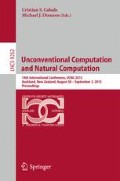Abstract
We explore some aspects of cell population dynamics in a wound-healing environment using a three-dimensional simulation model for multicellular tissue growth. The computational model uses a discrete approach based on cellular automata to simulate wound-healing times and tissue growth rates of multiple populations of proliferating and migrating cells. Each population of cells has its own division, motion, collision, and aggregation characteristics resulting in a number of useful system parameters that allow us to investigate their emergent effects. These random dynamic processes can be modeled by appropriately choosing the governing rules of the state transitions of each computational site. Discrete systems of this kind constitute an important approach for studying the temporal dynamics of complex biological systems.
Access this chapter
Tax calculation will be finalised at checkout
Purchases are for personal use only
References
Palsson, B.O., Bhatia, S.N.: Tissue Engineering. Pearson Prentice Hall, Upper Saddle River (2004)
Soll, D., Wessels, D.: Motion Analysis of Living Cells: Techniques in Modern Biomedical Microscopy. Wiley-Liss, New York (1998)
Langer, R., Vacanti, J.P.: Tissue engineering. Sci. 260, 920–926 (1993)
Ben Youssef, B.: A visualization tool of 3-D time-varying data for the simulation of tissue growth. Multimed. Tools Appl. 73(3), 1795–1817 (2014)
Tchuente, M.: Computation on automata networks. In: Soulie, F.G., Robert, Y., Tchuente, M. (eds.) Automata Networks in Computer Science: Theory and Applications, pp. 101–129. Princeton University Press, Princeton (1987)
Deutsch, A., Dormann, S.: Cellular Automaton Modeling of Biological Pattern Formation: Characterization, Applications, and Analysis. Birkhauser, Boston (2005)
Chopard, B., Droz, M.: Cellular Automata Modeling of Physical Systems. Cambridge University Press, Cambridge (1998)
Schaller, G., Meyer-Hermann, M.: Multicellular tumor spheroid in an off-lattice voronoi-delaunay cell model. Phys. Rev. E 71(5 Pt 1), 051910 (2005)
Beyer, T., Meyer-Hermann, M.: Delauny object dynamics for tissues involving highly motile cells. In: Chauviere, A., Preziosi, L., Verdier, C. (eds.) Cell Mechanics: From Single Scale-Based Models to Multiscale Modeling, pp. 417–442. CRC Press, London (2010)
Fu, Y.X., Chaplin, D.D.: Development and maturation of secondary lymphoid tissues. Annu. Rev. Immunol. 17, 399–433 (1999)
Beyer, T., Schaller, G., Deutsch, A., Meyer-Hermann, M.: Parallel dynamic and kinetic regular triangulation in three dimensions. Comput. Phys. Commun. 172(2), 86–108 (2005)
Cordelia, Z., Mi, Q., An, G., Vodovotz, Y.: Computational modeling of inflammation and wound healing. Adv. Wound Care 2(9), 527–537 (2013)
Bratley, P., Fox, B.L., Schrage, L.E.: A Guide to Simulation, 2nd edn. Springer-Verlag, New York (1987)
Majno, G., Joris, I.: Cells, Tissues, and Disease: Principles of General Pathology. Oxford University Press, New York (2004)
Acknowledgments
The author would like to acknowledge the support for this research work from the Research Centre in the College of Computer and Information Sciences as well as the Deanship of Scientific Research at King Saud University.
Author information
Authors and Affiliations
Corresponding author
Editor information
Editors and Affiliations
Rights and permissions
Copyright information
© 2015 Springer International Publishing Switzerland
About this paper
Cite this paper
Ben Youssef, B. (2015). Exploring the Effect of Cell Heterogeneity in Wound Healing Using a 3D Multicellular Tissue Growth Model. In: Calude, C., Dinneen, M. (eds) Unconventional Computation and Natural Computation. UCNC 2015. Lecture Notes in Computer Science(), vol 9252. Springer, Cham. https://doi.org/10.1007/978-3-319-21819-9_7
Download citation
DOI: https://doi.org/10.1007/978-3-319-21819-9_7
Published:
Publisher Name: Springer, Cham
Print ISBN: 978-3-319-21818-2
Online ISBN: 978-3-319-21819-9
eBook Packages: Computer ScienceComputer Science (R0)

